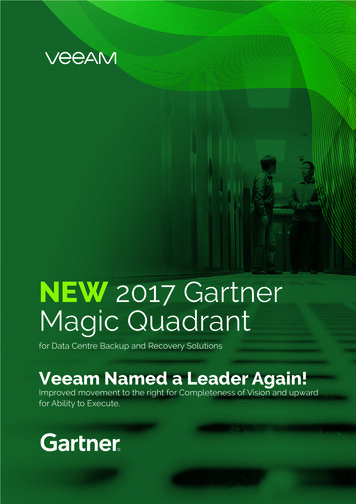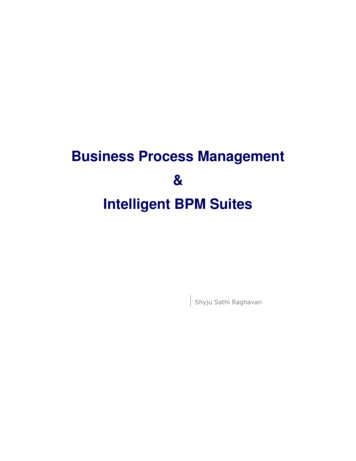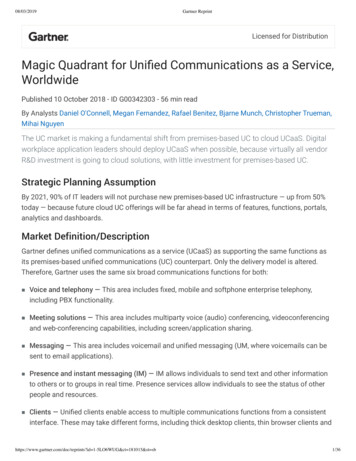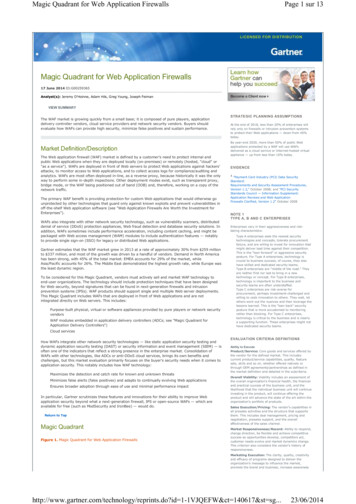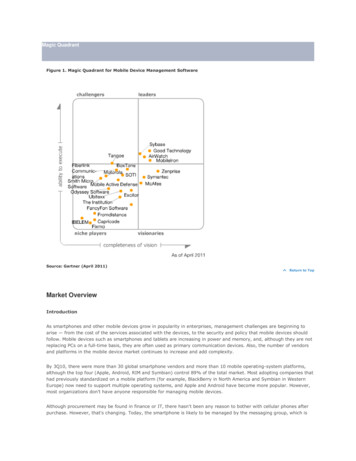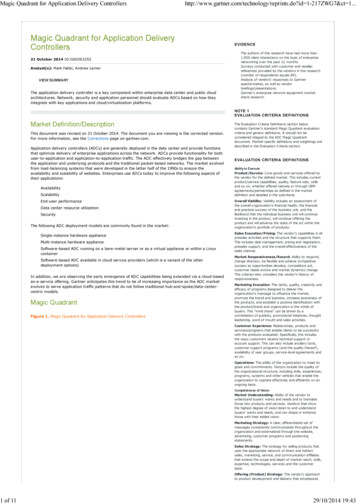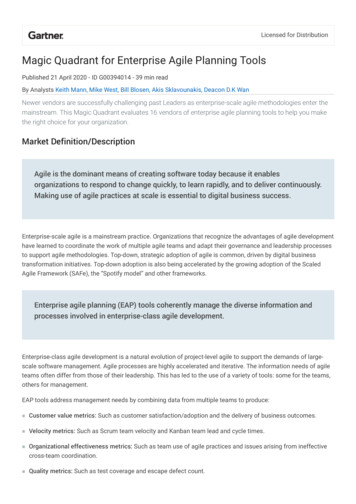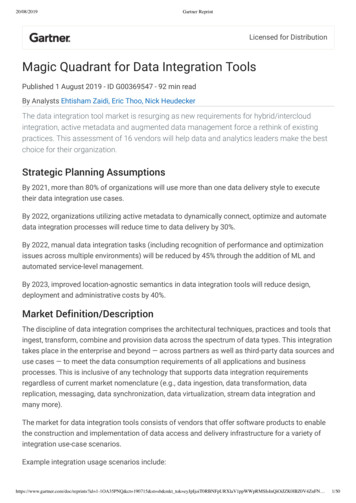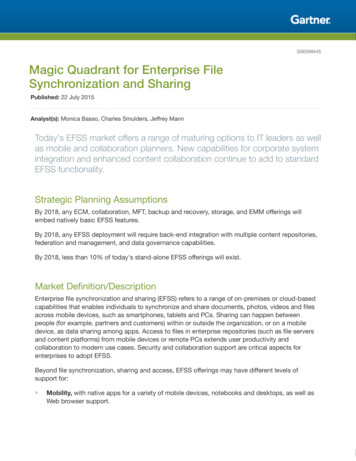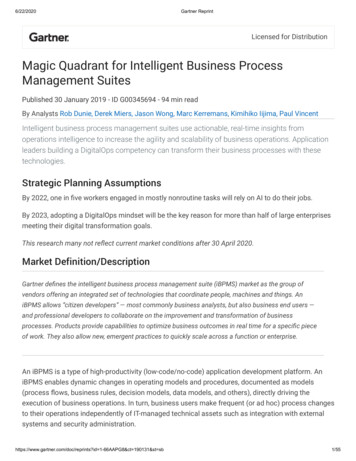
Transcription
6/22/2020Gartner ReprintLicensed for DistributionMagic Quadrant for Intelligent Business ProcessManagement SuitesPublished 30 January 2019 - ID G00345694 - 94 min readBy Analysts Rob Dunie, Derek Miers, Jason Wong, Marc Kerremans, Kimihiko Iijima, Paul VincentIntelligent business process management suites use actionable, real-time insights fromoperations intelligence to increase the agility and scalability of business operations. Applicationleaders building a DigitalOps competency can transform their business processes with thesetechnologies.Strategic Planning AssumptionsBy 2022, one in five workers engaged in mostly nonroutine tasks will rely on AI to do their jobs.By 2023, adopting a DigitalOps mindset will be the key reason for more than half of large enterprisesmeeting their digital transformation goals.This research many not reflect current market conditions after 30 April 2020.Market Definition/DescriptionGartner defines the intelligent business process management suite (iBPMS) market as the group ofvendors offering an integrated set of technologies that coordinate people, machines and things. AniBPMS allows “citizen developers” — most commonly business analysts, but also business end users —and professional developers to collaborate on the improvement and transformation of businessprocesses. Products provide capabilities to optimize business outcomes in real time for a specific pieceof work. They also allow new, emergent practices to quickly scale across a function or enterprise.An iBPMS is a type of high-productivity (low-code/no-code) application development platform. AniBPMS enables dynamic changes in operating models and procedures, documented as models(process flows, business rules, decision models, data models, and others), directly driving theexecution of business operations. In turn, business users make frequent (or ad hoc) process changesto their operations independently of IT-managed technical assets such as integration with externalsystems and security s?id 1-66AAPG8&ct 190131&st sb1/55
6/22/2020Gartner ReprintAn iBPMS allows organizations to: Manage the reinvention of existing business processes and the creation of novel businessprocesses in support of both digital optimization and digital transformation efforts Support top-down and bottom-up redesign of its business operations and processes Improve the business outcomes of all types of work, not just structured and repeatable businessprocessesAn iBPMS Brings Real-Time Situational Awareness to Business OperationsAn iBPMS has higher-intelligence capabilities in at least four of the eight dimensions of the GartnerBusiness Process IQ Framework (see Note 1): Data timeliness Context granularity Predictive power ActionabilityMore advanced iBPMS offerings may also feature capabilities in the other four dimensions of theframework: Contextual extensibility Decision diversity Optimization Behavioral impact captureA highly intelligent iBPMS — that is, one with higher-intelligence capabilities on most of the processIQ framework dimensions — can provide the foundation to industrialize the digital customer andemployee experience. It does this by: Connecting customer and partner interactions to back-office operations and supplier ecosystemsin a context-aware, situationally adaptive way Assessing, in real time, business operations based on the goals of the business, its partners andcustomers, to continuously update the set and order of interactions among process participants —potentially creating uniquely choreographed processeshttps://www.gartner.com/doc/reprints?id 1-66AAPG8&ct 190131&st sb2/55
6/22/2020Gartner Reprint Proactively personalizing contextually aware interactions at scale, to support rapid transformationand/or improvement of the customer and employee journeyEffectively, an iBPMS automates, orchestrates and choreographs (see “Decision Point for API andService Implementation Architecture”) business processes that shape themselves as they run. Theseprocesses can therefore be considered adaptive and intelligent — executing the best next actioninstead of the same repeatable sequence of actions. This requires a blend of contextual awareness,effective decision management, responsiveness to events and advanced analytics.iBPMS platforms: Choreograph complex styles of work, such as adaptive case management Provide tooling to automate operational decisions and enable humans to exercise their judgment Handle complex events, even using them to coordinate action Deliver advanced analytics to more-intelligently orchestrate and choreograph business processesThese insights manifest themselves at two levels: At the macrolevel: Using continuous intelligence (stream analytics, complex-event processing orbusiness activity monitoring), an iBPMS continuously monitors operations and identifiesopportunities to improve outcomes — for example, anomaly or exception detection. It alsoencompasses on-demand analytics such as critical path and workload volume analysis. It is usedto drive improvements in the process design, which is often useful in continuous processimprovement and business transformation efforts. At the microlevel: Using real-time analytics, decision automation (such as via decision models,predictive analytics and machine learning [ML]) and decision support for knowledge workers, aniBPMS drives improvements in the execution of a particular process instance or case. This isuseful in ways that go beyond traditional business transformation to the execution of digitalizedprocesses.iBPMS Capabilities Form the Foundation of a DigitalOps CapabilityAn iBPMS plays an important role in facilitating the creation of a digital twin for your businessoperations. It seamlessly brings together several of the core components of a business operatingsystem — most commonly the operating model of the business, enterprise performancemanagement, operational intelligence, and business decisions (see “Create a Digital Twin of YourOrganization to Optimize Your Digital Business Transformation d 1-66AAPG8&ct 190131&st sb3/55
6/22/2020Gartner ReprintAn iBPMS thereby provides real-time insights supporting “DigitalOps” — that is, hyperagility at thebusiness level through continuous change to the business operating model and business processesat the pace of DevOps (see “DigitalOps Helps Connect Business Models to the Digital BusinessPlatform”). This allows for the rapid and continuous improvement of a business process, orexperimentation with new customer experiences and operating models.Magic QuadrantFigure 1. Magic Quadrant for Intelligent Business Process Management SuitesSource: Gartner (January 2019)https://www.gartner.com/doc/reprints?id 1-66AAPG8&ct 190131&st sb4/55
6/22/2020Gartner ReprintVendor Strengths and CautionsAgilePointNote: AgilePoint declined to fully participate in the research process for this Magic Quadrant; itidentified no reference customers and did not complete the vendor survey. Gartner’s analysis ofAgilePoint in this Magic Quadrant is therefore based on other credible sources, including previousvendor briefings, customer inquiries, Gartner Peer Insights reviews and other publicly availableinformation. Gartner Peer Insights reviews of AgilePoint (at the time of writing) point to average overallsatisfaction.AgilePoint offers an iBPMS built on Microsoft .NET architecture and primarily deployed on-premisesby customers. However, it is rapidly transitioning to single-tenant and multitenant cloud offerings viaMicrosoft Azure and Amazon Web Services (AWS). The platform enables business and IT tocollaborate on developing both process-driven and form-based applications. The following analysisrefers to AgilePoint NX 6.x; AgilePoint NX 7.0 was released after the cutoff date for this MagicQuadrant, but the product roadmap is considered in our assessment of the vendor’s Completeness ofVision.Strengths AgilePoint is typically one of the more cost-effective offerings in the iBPMS market. AgilePoint NXis licensed using a variety of different models, giving the customer flexibility to choose theapproach that will scale best with their needs. It offers a free Community Edition with fullcapabilities for building proofs of concept (POCs), or for small-scale deployments (up to 10 namedusers). AgilePoint is a strong fit for organizations looking for an easy-to-use iBPMS that leveragesMicrosoft investments, including Office 365, Dynamics CRM, SQL Server, and Azure AI and IoTservices. With NX 7.0, AgilePoint increases the number of integration connectors to more than 70cloud applications and on-premises systems. New connectors provide integration with chatbots,machine learning services, robotic process automation (RPA), and others. AgilePoint enables citizen developers to easily compose process-centric applications. It offers alow-code authoring experience. Its eForms Builder offers a drag-and-drop tool with more than 60form controls that are responsive across device form factors. In release NX 7.0, AgilePoint plansto introduce further usability enhancements to both authoring and end-user experiences.Cautions AgilePoint provides limited analytics and decision management capabilities in its platform.Predictive analytics gets partial support through the AgileExtender Framework, while advancedanalytics, complex-event processing (CEP) and complicated reporting require integration to thirdparty subscription services, such as those from Microsoft. Process discovery and d 1-66AAPG8&ct 190131&st sb5/55
6/22/2020Gartner Reprintcapabilities also require customizations through the AgileExtender Framework. Its native businessrules and decision management capabilities are among the weaker aspects of the platform,relying on third-party decision automation engines for more sophisticated customer requirements. While AgilePoint gets a degree of customer mind share that is comparable to some of its mostdirect competitors, it has not translated this into comparable market share. This is largely due toits having a less-mature service and technology partner ecosystems. AgilePoint NX 7.0 promises to advance usability of both the design-time and runtime experiences,and provide more robust mobile capabilities. However, it does not significantly address some ofthe shortcomings, particularly around its decision management and analytics capabilities, which —based on market demands — are bigger gaps in AgilePoint’s offering.AppianThe Appian development platform combines low-code development with process management toallow both IT and citizen developers to construct process-centric and case-centric applications. TheAppian platform enables enterprises to adapt their processes for ongoing process improvement andbusiness transformation. The following analysis refers to the Appian 18.2 release.Strengths The Appian platform performs strongly across all the criteria for iBPMS platforms. The offeringprovides a highly capable suite of tools for citizen developers that includes process modeling, UIdesign and decision design. Of significant interest was the inclusion of support for “boxedexpressions” from the Decision Model and Notation (DMN) standard. The addition of a “records”view for knowledge workers complements the traditional process inbox. Further, the AppianAppMarket provides a range of accelerators, tools and extensions built on the platform by eitherAppian or its partners. Appian’s value for money compared well with that of the other Leaders in this Magic Quadrant.Customer references also indicated a higher degree of satisfaction with their overall platformexperience, compared with the other vendors surveyed. Appian customer references stated thatthey use Appian for implementing multiple processes that span cross-functional boundaries, withmost indicating that they use the platform to optimize interactions with partners. Similarly, themajority were experimenting with radical changes to their operating models. Since our last evaluation, Appian has enhanced the scalability of its platform, doubling the numberof processes, increasing memory, and supporting the containerization of the platform via Dockerand Kubernetes. This further supports high availability of the cloud platform and facilitates itsmulti-data-center offering and low recovery time objective (RTO) eprints?id 1-66AAPG8&ct 190131&st sb6/55
6/22/2020Gartner Reprint Customer references for Appian cited contract negotiation and pricing flexibility as areas ofconcern. While Appian has experimented with a variety of pricing models, some customerreferences considered its pricing model unclear. Although Appian provides performance analytics on business processes, the design experiencefor data outside of that process is limited. Native data visualization is restricted to grids andcommon chart types. Moreover, while the inclusion of boxed expressions from the DMN standardis useful, there is no decision requirements diagram and the Appian expression language is stillpervasively used. Appian has added native sentiment analysis and preintegrated components for ML from majorplayers such as Microsoft, Google and Amazon, but lacks the native ML capabilities that themarket is demanding.AuraPortalAuraPortal Helium is a .NET-based platform that provides highly intelligent capabilities within a singleintegrated repository. AuraPortal is currently expanding its reach — moving from midsize to largerorganizations and continuing to build momentum in the North American market. This analysispertains to AuraPortal Helium version 4.5.Strengths Through better marketing efforts and messaging — such as co-branding in certain regions, co-creating whitepapers with Microsoft, and leveraging worldwide Microsoft events — AuraPortal hasstrengthened its position within the
AgilePoint in this Magic Quadrant is therefore based on other credible sources, including previous vendor briefings, customer inquiries, Gar tner Peer Insights reviews and other publicly a vailable information.

